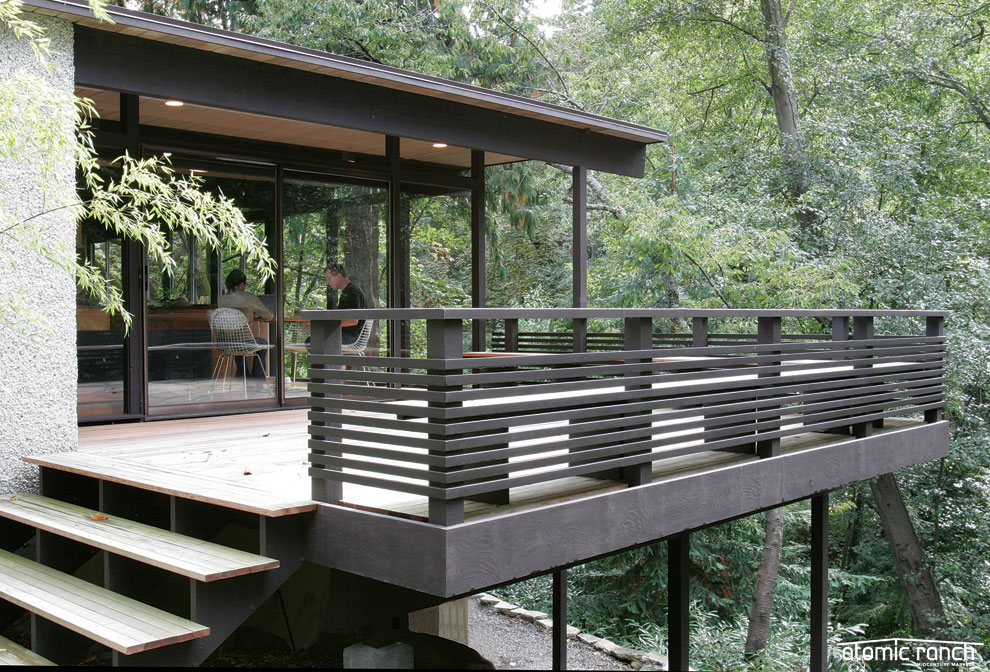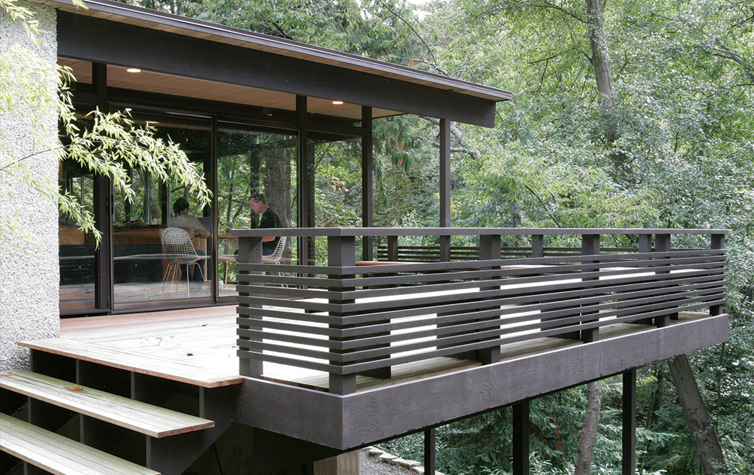
To meet Erich Volkstorf and tour his 1961 home in the Seattle suburb of Shoreline is to understand that finding the proper oven, the perfect stain for the beams or the correct hardware for the sliding closet doors takes time. Lots of time. The oven needed to be 24” wide not 36”, which led to 60 hertz Baumatic double ovens shipped from Taiwan.
Advice to just paint the flat-roof home’s beams didn’t fly, and Volkstorf fiddled until he landed on a coffee-brown solid body stain with a linseed oil wipe on top. New aluminum replacement windows— switched out from double pane to single pane (no, that’s not a typo)—came with a shiny mill finish, so he scrubbed the frames with a Scotch-Brite pad, then delivered them to a plating house for acid etching and clear anodizing before the glass was installed.
It took two years of working with a machinist friend to craft the aforementioned closet doorstops, bumpers and bottom glides. The winning combo was brass stops with rare earth magnets, UHMW bumpers and, for the glides, stainless steel pins that ride in UHMW tracks routed into the bottom of the doors. Easy. It’s no wonder it took them four years to almost finish the remodel of their Seattle gem.
“He never takes ‘No’ for an answer,” sighs tile artist Laura Brodax, Volkstorf’s wife. “You have to keep digging and digging; it’s painful. I’m the assistant here, helping make the calls. He comes up with the concept and we continue to pursue it beyond where anyone else would hope to go.”
Volkstorf admits he revels in finding the house fittings that you supposedly can’t get anymore and has launched a consulting business for owners of midcentury homes facing the same dilemmas. Case in point, the sheer, organic, natural curtains he envisioned for the window walls. After numerous dead ends, he punted to Brodax, who finally found what they were looking for at Seattle Curtain. Or the pin hinges they needed for the copious built-in cabinetry. New ones weren’t up to Volkstorf’s quality standards and cost $5 a pair.
After a laborious archival search he found a company in New York who made them back in the day. The minimum order was 300 but they were only a quarter apiece. “A lot of times, these old places say, ‘That’s not a problem; you can get that,’ while the new people say they’ve never seen it and it hasn’t been made in 50 years,” Volkstorf, a former cine- matographer, comments.
But before they could labor over every detail, they had to find the house – No small feat.
After going to a party in a Modernist house, the couple came back to their painstakingly renovated bungalow on a busy street. “We thought, Wait! There’s something better out there,” Brodax recalls of their conversion to midcentury.
“For some people, there’s nostalgia with wanting to recapture part of their youth and the house they grew up in. In my case, it was a Modernist house,” says Volkstorf. “A few years ago, they could be had for next to nothing because people would say, ‘That’s a home like I grew up in; it’s 50 years old, it’s a teardown.’”
“The hotbed of modernism has really been in Los Angeles. Celebrities are actually collecting them: ‘I have two Neutras and a Lautner, but I sold my Schindler,’ ” he parodies. “But there are still incidents like the Maslon House that got torn down in Rancho Mirage, which generated a fair amount of press and outrage. People started seeing they were worth preserving. That’s crept up the coast and gone east, and now people are recognizing the work of Breuer and Gropius and Johnson.”
But in Seattle, the right house in the right setting wasn’t gelling. “We had been looking for three years and were really discouraged,” Brodax says. “The Modernist homes closer to town had been so rearranged and changed that we’d be paying for someone else’s vision, which we’d have to then undo. At this point, we were looking for a crummy house overlooking a ravine, a teardown where we could build new.”
How did this love affair between a couple and an unassuming home begin? Check back in part 2 to read when Cupid’s arrow first struck!













